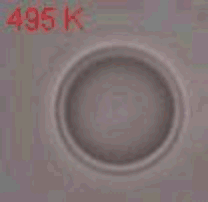Research
Imaging Dynamics at the Nanoscale
The ability to directly visualize physical processes at play has contributed immensely to our fundamental understanding of the liquid, crystal, and glassy states of matter. A cliched example is Robert Brown’s real-space observation of the incessant motion of pollen grains in water, which led to the theory of Brownian motion and, in essence, laid the foundation for the existence of atoms and molecules. Our overarching goal is to exploit a newly acquired facility by our group, also the first in India, wherein we exploit the high-spatial-resolution offered by transmission electron microscopy (TEM) to image dynamics at the nanoscale.
(Movie: Dynamics of a 35 nm gold nanoparticle in water)

Condensed Matter on Curved Surfaces
Consider the ordered arrangement of billiard balls on a table before the start of the game. Excluding the ones at the edges, each ball has precisely six neighbors in contact. This arrangement has a hexagonal symmetry and also happens to be the densest packing of spheres in two-dimensional flat space. Curved space, however, cannot be fully tiled by particles having six-fold coordination, i.e., by hexagons alone. For instance, tiling the simplest closed surface, the sphere also requires twelve pentagons (e.g., a soccer ball, a viral capsid, C60 molecule). The question now is how does this frustration induced by curvature alter the behavior of condensed phases. We address this question by directly visualizing the dynamics of colloidal crystals and glasses on complex topologies.
(Video: liquid made of size bi-disperse colloidal particles on a sphere)

Active Matter
In the last two decades there have been significant strides in our understanding of how large collections of living organisms, be it bird flocks, fish schools, or wildebeest herds, spontaneously form enthralling large scale collective patterns despite very simple, and often purely local, interaction rules. These systems broadly classified as "active matter" are at the forefront of statistical physics and condensed matter research. Our goal is to realize laboratory model systems – inanimate particles that are rendered active by pumping energy into the system – that mimic such behavior so as to enable experimental studies in a more controlled setting.
(Video: Active millimeter-sized ellipsoidal particles)

Stochastic Heat Engines
Micro- and nanoscale motors and engines operate in a regime swamped by fluctuations. Unlike the familiar macroscopic engines, where the large number of degrees of freedom (DOF), ~ O(10^23), of the working fluid, essentially smothers away fluctuations, for microscopic ones, the number of DOF ~ O(10^1) and fluctuations in key engine parameters like efficiency and power become apparent. Thus, albeit infrequently, a biological motor carrying cargo within a cell can stall and even take a backward step and a micrometer-sized colloidal heat engine can operate in reverse as a refrigerator.
Theoretical advances in stochastic thermodynamics have helped elucidate the mechanisms of energy transduction of these micro- and nano-sized machines operating between equilibrium thermal baths. In many situations, however, the bath themselves can be out-of-equilibrium, inside a living cell for instance. Our goal is to understand the influence of the non-equilibrium nature of the bath on the performance of these engines.
(Video: A Stirling heat engine with a single colloidal particle as the working substance)

Template-directed Colloidal Self-assembly
Guiding atomic and molecular self-assembly by structured surfaces is a well-established route for fabricating functional surface nano and micro structures. Surface guided self-assembly of micron-scale particles (colloids) can not only shed light on the various processes at play, often inaccessible at the atomic and molecular length scales, but also help realize materials for applications that include structural color filters and photonic bandgap devices.
Research in this area in our group focuses on extending atomic epitaxial growth concepts to microparticles. In due process, we not only attempt to identify phenomena unique to colloidal surface growth but also develop new design principles in overcoming the experimental challenges in extending atomic surface growth ideas to the colloidal realm.
(Picture: Hierarchical assembly of micrometer-sized colloidal particles on a template)

Glasses and Glass Transition
When you cool a liquid rapidly enough to avoid crystallization, particle dynamics slows down and eventually ceases at the glass transition. Unlike conventional equilibrium critical phenomena where a diverging relaxation time is due to growing static correlations, no obvious structural changes accompany the glass transition. The grand challenge in contemporary condensed matter physics is to ascertain if the slowing down of dynamics en route to forming glass is a purely kinetic phenomenon - structure has no role - or a thermodynamic one - has a structural origin.
Research in this area in our group is aimed at addressing the following issues:
Is there a structural origin for the slowing down of dynamics on approaching the glassy state?
Which of the current theoretical scenarios best capture the observed slowing down?
How do glasses flow?
How does particle shape influence glassy dynamics?
Memory formation in amorphous packings
How do glasses crystallize?
(Picture: Microscope image of time-averaged colloidal particle dynamics near a frozen wall of particles)

Flow of Suspensions
Unlike Newtonian liquids wherein the viscosity remains constant over a wide range of imposed shear rates, in soft materials the strong coupling of the underlying mesoscopic structure to the imposed shear often results in remarkable and non-trivial dependence of viscosity on shear rate. While the phenomenon of shear-thinning - wherein the viscosity reduces with shear rate - is ubiquitous in soft materials, the opposite trend - shear-thickening - is mostly seen in surfactant systems, and dense colloidal and granular suspensions. Current mechanisms that attempt to explain shear-thickening include but are not limited to, the formation of hydro clusters and the interlocking of particles due to friction.
By combining rheological measurements with simultaneous 3-dimensional single-particle imaging using a confocal microscope, we are currently exploring the role of particle shape on the rheological behaviour of colloidal suspensions.
(Picture: Microscope image of colloidal rods)

Defect Dynamics in Crystals
"Crystals are like people, it is the defects in them which tend to make them interesting" - Colin Humphreys
The role defects play in determining the properties of crystalline materials cannot be overstated. They are not only vital in determining the yield strength and the deformation mechanisms of crystals but also dictate their electronic and optical properties. Elucidating the dynamics of defects with and without external perturbations continues to remain a key goal of materials research. The difficulty with atomic systems, however, is that the length and time scales are too small to capture the dynamics of defects and interactions between them.
By using micron-scale colloidal particles as substitutes for individual atoms, we scale up the problem so that defect dynamics can be observed in the presence and absence of external mechanical forcing and in real-time using a confocal-rheoscope.
(Picture: Grain boundary in a colloidal crystal)

